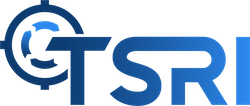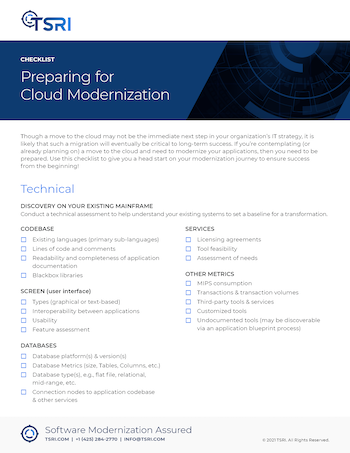Displaying items by tag: modernization
4 Tips for Modernizing with Minimal Business Disruption

Let’s face it. Change is hard. Sometimes, however, change is necessary. When it comes to modernizing mainframe systems that have been in service for decades — especially when considering the possible risks — change requires a lot of forethought.
Disruption to your organization’s business will likely be one of the biggest risk areas in question. These risks can run from prolonged periods that take your business offline to database synchronization between your existing and target applications. So how do organizations move forward with a much-needed modernization to the cloud or a hybrid on-premises solution without causing major disruptions or headaches to their business?
 Here are four tips to help you minimize business disruption risks:
Here are four tips to help you minimize business disruption risks:
1. Understand the scope of your modernization project.
Your organization may want to modernize your applications all at once, but more likely will consider a proof of concept. Great candidates for a proof of concept could be applications most critically in need of modernization, or less-utilized applications to demonstrate how a cloud or on-premises hybrid migration will holistically affect your overall systems portfolio. Understanding the application make-up and baselines of your existing applications will help uncover any additional services that may be required for a successful modernization and determine the target environment these applications will live on and language they use. Setting a realistic scope early on will give insight into which cloud services your applications can leverage, and the benefits associated with those services. Having a good understanding of the scope of the modernization before the work begins will eliminate surprises down the road as well and help prepare for subsequent steps in your organization’s modernization journey.
2. Consider a graceful migration and gradual roll-out.
With the right solution, your organization has the capability to migrate legacy systems one feature, one function, or even one API at a time. Both the existing and modernized applications can then coexist and run concurrently while maintaining or replicating the same data sources. One TSRI client actually operated in this state for over a year as we completed their modernization!
3. Put your services in the target environment under the control of your legacy environment.
Rather than remaking all of the thousands of processes that run to complete specific tasks, organizations can work on the new target environment following a code migration and create a “cloud agent” to enable the legacy mainframe system to run these processes. This temporary fix mitigates risk by eliminating the challenge of isolating problems in real time and allows organizations to move the processes from the legacy application.
4. Take advantage of automation.
Automated modernization processes eliminate the need for humans to rewrite tens (if not hundreds) of thousands of lines of code, which will inevitably introduce errors that need to be isolated and remediated. Manual rewrites can also take years. While human intervention is likely required at various points in an automated modernization, a programmer will need to touch less than .05% of a codebase, meaning issues can be remediated in hours or a few days rather than weeks. Read more about the advantages of automated modernization.
While any modernization will cause some level of disruption, a trusted partner with the experience, tools, and methods in place to migrate legacy systems will minimize risk and make your move to the cloud or a hybrid on-premises architecture as seamless as possible. An experienced, knowledgeable partner will also keep your business requirements top of mind. Remember, automated modernization and refactoring processes will update your code but do not change your business functions. Everything in your applications will perform exactly as they did prior to your modernization—and most likely better— and also enable your organization to leverage the benefits of cloud computing and the up-to-date processes modern systems offer.
---
TSRI is Here for You
As a leading provider of software modernization services, TSRI enables technology readiness for the cloud and other modern architecture environments. We bring software applications into the future quickly, accurately, and efficiently with low risk and minimal business disruption, accomplishing in months what would otherwise take years.
Modernize your High Value Assets Using Government TMF Funding
 Modernization of High Value Assets (HVAs) and software systems is more urgent than ever. In the past year, tens of millions of U.S. citizens have leveraged critical online systems to manage their livelihood and health during the COVID-19 pandemic. With such a heavy reliance on these systems, now is the time for the federal government’s critically important HVAs systems to keep up with citizens’ growing needs.
Modernization of High Value Assets (HVAs) and software systems is more urgent than ever. In the past year, tens of millions of U.S. citizens have leveraged critical online systems to manage their livelihood and health during the COVID-19 pandemic. With such a heavy reliance on these systems, now is the time for the federal government’s critically important HVAs systems to keep up with citizens’ growing needs.
The Technology Modernization Fund was established in 2017 to support government and civic agencies to bring their critical software infrastructure into the modern age. On May 12 of this year, President Biden issued a comprehensive executive order that gave direction to federal departments and agencies to strengthen the government’s cybersecurity posture. The order establishes a requirement to modernize systems and implement stronger cybersecurity standards by moving agencies and their contract partners to secure cloud services and a zero-trust architecture, which uses identity management protocols to verify that every user of a system interacts with the appropriate levels of security access. This order also mandated deployment of multifactor authentication and encryption.
According to Federal Chief Information Security Officer Chris DeRusha, the White House is pushing federal agencies toward a “zero-trust paradigm.” With the pressure on, many agencies are struggling with the magnitude of such an undertaking and are, justifiably, fearful of the perceived security and down-time risks associated with modernization.
Modernizing an HVA doesn’t have to be risky
Using a graceful, automated approach to leverage modernization solutions can result in a very low risk modernization. By implementing a step-by-step cloud migration while keeping legacy systems running in parallel, an automated modernization can happen quickly, safely, and reliably.
TSRI has over 25 years of experience undertaking migrations of this kind (see below).
- TSRI’s Work is the “Playbook” for Future Government Modernization
A large percentage of TSRI’s work over the past 25 years has been the modernization of critical government and military software applications. If fact, our recent work with HUD was called the “playbook” for future government modernization.
- Modernize Quickly and Maintain Business-as-Usual in the Process
Our technology enables HVAs to be modernized rapidly and without business disruption.
- Cloud-Ready, Cloud-certified — AWS & Beyond
As a certified AWS partner for mainframe modernization, TSRI helps organizations take advantage of the Technology Modernization Fund to transform and secure their applications for cloud deployment on AWS and other leading platforms.
- Case Study — COBOL to Java: USAF Modernization for AWS
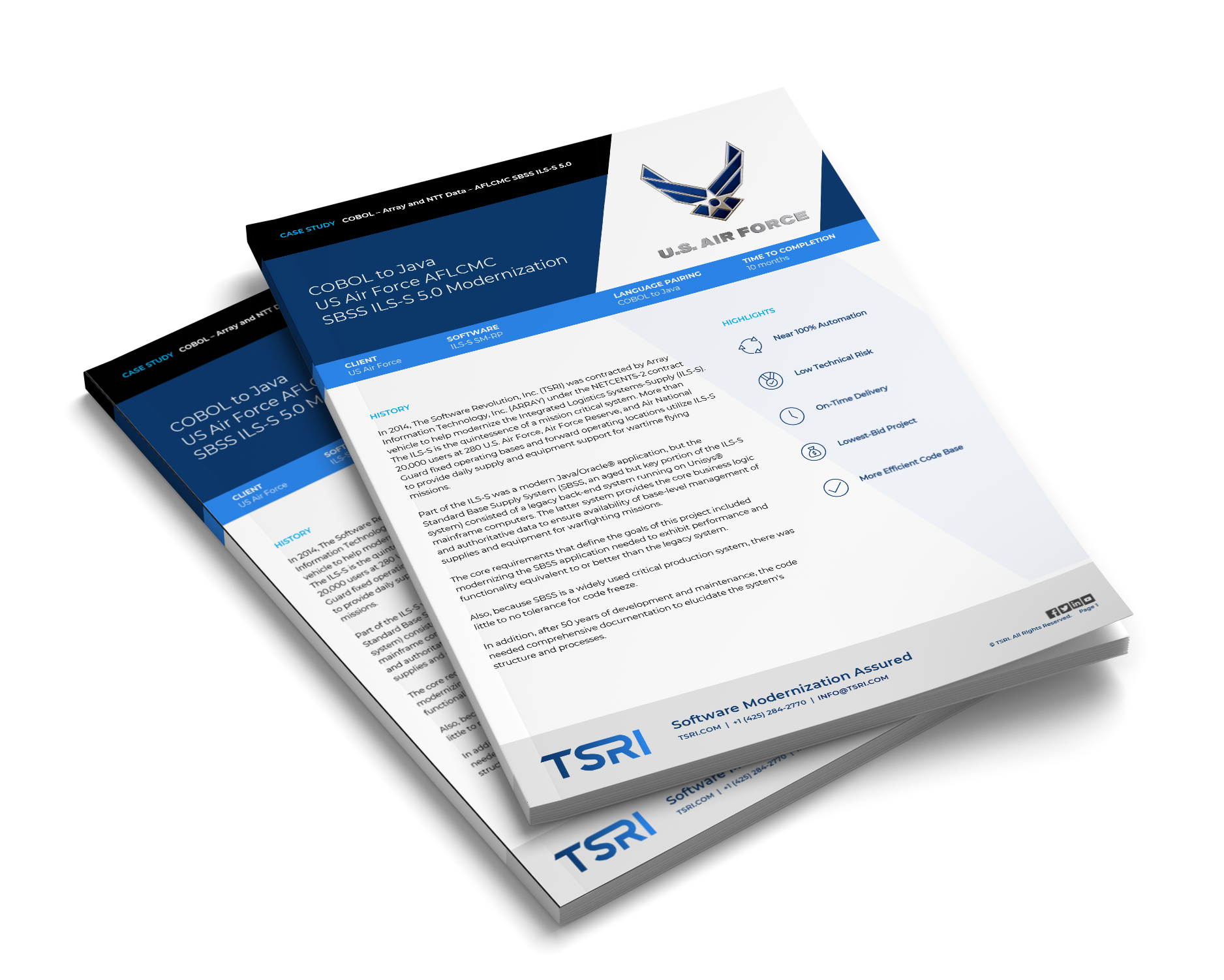
Ready to modernize? Reach out to us to learn more and get started!
-----
TSRI is Here for You
As a leading provider of software modernization services, TSRI enables technology readiness for the cloud and other modern architecture environments. We bring software applications into the future quickly, accurately, and efficiently with low risk and minimal business disruption, accomplishing in months what would otherwise take years.
Get started on your modernization journey today!
Virtual Event on May 18: Modernizing for the Future
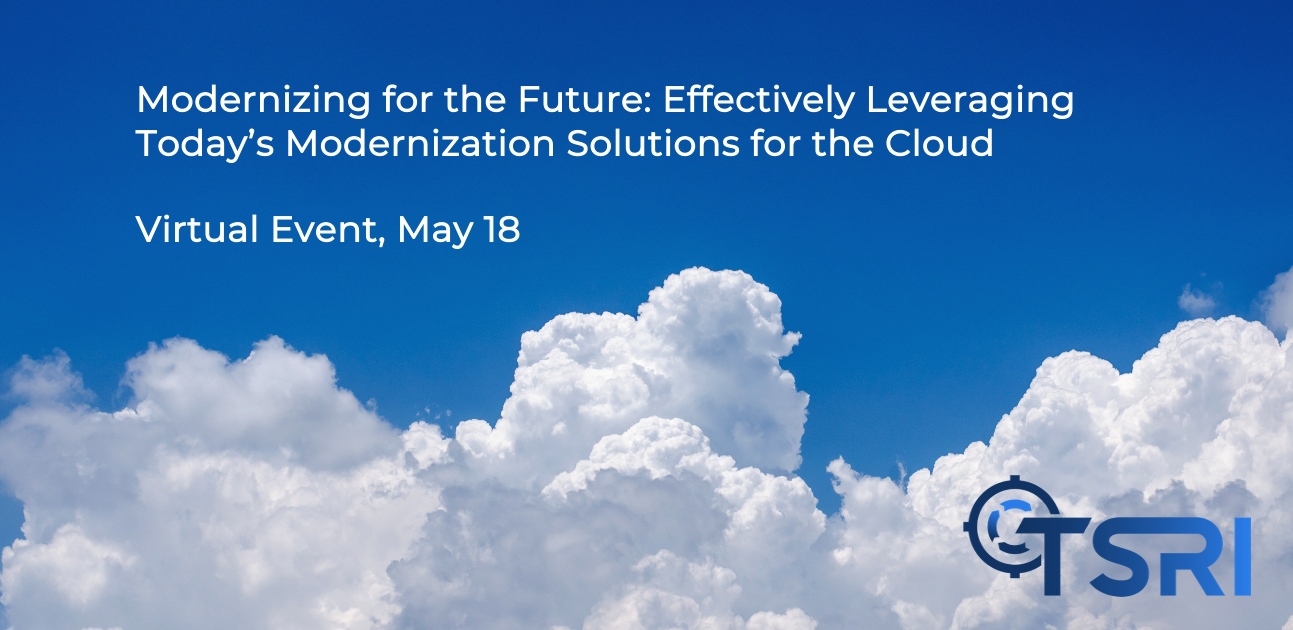
Any organization undergoing a modernization needs to understand the new environment they will be moving to. When it comes to cloud migration, the path to successful execution is not always clear.
TSRI’s VP of Product Development and Service Delivery, Scott Pickett, will lead a live virtual session to help organizations work through the benefits and challenges of modernizing for the cloud. Scott will reference case studies from many of the successful cloud migrations he and his team at TSRI have undertaken.
Modernizing for the Future: Effectively Leveraging Today’s Modernization Solutions for the Cloud
Tuesday, May 18 at 11:00am (PDT)
In this session, Scott will explain what the landscape of constantly evolving technology options means for organizations looking to modernize their code, databases, and UI as they move to the cloud. While the options at first may seem daunting, the insights Scott has gathered from many years in the field and numerous successful modernization and cloud-migration programs will ease a lot of anxiety among both business and IT professionals.
Scott’s session will be presented virtually with a live Q&A. Don’t miss your chance to attend this value-packed session!
Some key takeaways you can expect from Scott in this session:
- Gain important insights to successfully move beyond language modernization and support best practices for deployment in a cloud environment.
- Learn about common benefits, challenges, and pitfalls in cloud migration and modernization.
- Dive into the specifics associated with modernizing COBOL programs and the tools, services, and tech stacks required to support them in a modern environment.
Register now to participate on May 18 for this live-streaming event!
-----------
TSRI is Here for You
As a leading provider of software modernization services, TSRI enables technology readiness for the cloud and other modern architecture environments. We bring software applications into the future quickly, accurately, and efficiently with low risk and minimal business disruption, accomplishing in months what would otherwise take years.
Checklist: Preparing for Cloud Modernization

Is modernizing your software applications to the cloud a topic of discussion in your organization? Though a move to the cloud may not be the immediate next step in your organization’s IT strategy, it is likely that such a migration will eventually be critical to long-term success. If you’re contemplating (or already planning on) a move to the cloud and need to modernize your applications, then you need to be prepared.
With hundreds of large-scale modernizations under our belt, the TSRI team has seen the good, the bad, and the ugly. While no modernization effort is without its bumps, there are things you can do to pave an easier path. We’ve developed a checklist to give you a head start on your modernization journey to ensure success from the beginning!
Technical
Discovery on your existing mainframe
Conduct a technical assessment to help understand your existing systems to set a baseline for a transformation.
CODEBASE
![]() Existing languages (primary sub-languages)
Existing languages (primary sub-languages)
![]() Lines of code and comments
Lines of code and comments
![]() Readability and completeness of application documentation
Readability and completeness of application documentation
![]() Blackbox libraries
Blackbox libraries
DATABASES
![]() Database platform(s) & versions(s)
Database platform(s) & versions(s)
![]() Database Metrics (Size, Tables, Columns, etc.)
Database Metrics (Size, Tables, Columns, etc.)
![]() Database type(s), e.g., flat file, relational, mid-range, etc.
Database type(s), e.g., flat file, relational, mid-range, etc.
![]() Connection nodes to application codebase & other services
Connection nodes to application codebase & other services
SCREEN (user interface)
![]() Types (graphical or text-based)
Types (graphical or text-based)
![]() Interoperability between applications
Interoperability between applications
![]() Usability
Usability
![]() Feature assessment
Feature assessment
-
SERVICES
![]() Licensing agreements
Licensing agreements
![]() Tool feasibility
Tool feasibility
![]() Assessment of needs
Assessment of needs
-
OTHER METRICS
![]() MIPS consumption
MIPS consumption
![]() Transactions & transaction volumes
Transactions & transaction volumes
![]() Third-party tools & services
Third-party tools & services
![]() Customized tools
Customized tools
![]() Undocumented tools (may be discoverable via an application blueprint process)
Undocumented tools (may be discoverable via an application blueprint process)
Physical Mainframe Review
Examines system architecture, technical services in use, and analysis of both internal and external services/applications. We can use this information to map your system to your desired target services and architecture.
![]() Existing architecture survey
Existing architecture survey
![]() Architecture diagram evaluation
Architecture diagram evaluation
![]() External applications assessment
External applications assessment
![]() Utilities and services assessment
Utilities and services assessment
![]() Services overlap within the full application portfolio
Services overlap within the full application portfolio
![]() Performance, quality, and security baselines and metrics
Performance, quality, and security baselines and metrics
SMEs/Personnel
While the technical review is important, it’s also useful to have an understanding of who on the team is able to maintain and develop on your existing systems. The logic and technical requirements may be different once you’ve established your target architecture.
![]() Survey of staffing (existing and future)
Survey of staffing (existing and future)
![]() Assessment of team’s working knowledge of applications
Assessment of team’s working knowledge of applications
![]() Talent assessment within market
Talent assessment within market
As you gather this information, TSRI uses its tools to assess the code, find any code modules/segments within applications that are no longer in use, and generate code-level documentation through a blueprint preview of the current codebase and what a future, modernized codebase might look like. We will then work with you to establish business requirements. Note that while many of these tasks individually take a short time, depending upon the number of applications and the size of your application portfolio, an end-to-end engagement can range anywhere from 1-2 years if your systems have fewer than 10 million lines of code to transform to 4-5 years for much larger portfolios and codebases.
Business
Business case development and financial discovery
Once you have completed a technical analysis and your IT leaders understand your existing systems, it is time to establish your organization’s business cases to modernize your applications and support a modern environment.
-
-
NEEDS ASSESSMENT
![]() Timeframe for project phases and project completion
Timeframe for project phases and project completion
![]() Market and internal demands
Market and internal demands
![]() Then vs. now: evolution of your customer and business needs
Then vs. now: evolution of your customer and business needs
![]() Modern workflows and accessibility
Modern workflows and accessibility
![]() Security posture
Security posture
-
-
CURRENT FINANCIAL STATE
-
![]() Total cost of mainframe and application ownership
Total cost of mainframe and application ownership
![]() Mainframe operating expenses
Mainframe operating expenses
![]() Capital expenditures
Capital expenditures
![]() Amortized costs
Amortized costs
-
-
INTANGIBLE COSTS BEYOND PRICE
-
![]() Market agility
Market agility
![]() Business requirements agility
Business requirements agility
![]() Availability of developers that support legacy systems
Availability of developers that support legacy systems
Download and print your own modernization checklist
While most businesses that rely upon mainframes will need to modernize in one way or another, every organization’s needs will be different. Base your organization’s decisions not just on the flashiest current technologies, but on the methodologies and technologies that will work best for your company today and into the future. TSRI can work with you to complete this checklist assessment to start you on the path of a fully automated mainframe modernization. Contact us now to begin!
TSRI is Here for You
As a leading provider of software modernization services, TSRI enables technology readiness for the cloud and other modern architecture environments. We bring software applications into the future quickly, accurately, and efficiently with low risk and minimal business disruption, accomplishing in months what would otherwise take years.
Get started on your modernization journey today!
Ada to Java and C++ - ITT / SENSOR
ITT Corporation awarded a sole-source contract to TSRI for modernization of the COBRA DANE Radar Calibration System (SCRS) of the Ballistic Missile Early Warning System (BMEWS) under the Air Force’s System Engineering & Sustainment Integrator (SENSOR) program.
- Customer & Integrator: US Air Force/ITT
- Source & Target Language: Ada to Java/C++
- Lines of Code: 380,300
- Duration: 8 months
- Services: Code Transformation, Automated Refactoring, System Integration, Testing & Implementation Support, Final “To-Be” Documentation
- ada
- C++
- Java
- itt
- Code Transformation
- Automatic Refactoring
- Final ToBe Documentation
- System Integration and Test Support
- System Integration
- usaf
- US Air Force
- modernization
- Refactor
- Refactoring
- html
- Remove Dead Code
- Common Coding Standards
- Software code Conversion
- Software Modernization
- ada to c++
- Software Design
Ada to C++ - Raytheon - TCS / MCS
Navy Multi-band Terminal (NMT) is a SATCOM terminal, which expands available bandwidth and provides support for ForceNet, the Navy's approach to network-centric operations. TSRI transformed the legacy Ada code to C++, and refactored the modernized application.
- Customer & Integrator: Raytheon & US Navy
- Source & Target Language: Ada to C++
- Lines of Code: 89,000
- Duration: 5 months
- Services: Automated Code Transformation, Transformation Blueprint, System Integration and Test Support, Automated Refactoring
Ada to C++ - US Navy - Modem Control Software
TSRI was engaged to modernize US Navy SATCOM Multi-band Terminal (NMT) Modem Control System (MCS) from Ada to C++. To provide SPAWAR with the best modernization approach, Raytheon selected TSRI to transform the existing MCS Ada code into C++ and to re-factor
the C++ toward the desired target architecture. TSRI's fixed-price "integrator ready" deliverable was selected by Raytheon for its low technical risk,
shortened schedule, and low cost.
- Customer & Integrator: US Navy & Raytheon
- Source & Target Language: Ada to C++
- Lines of Code: 190,000
- Duration: 5 months
- Services: Automated Code Transformation, Application Blueprint®, Transformation Blueprint®, Engineering Support, Automated Refactoring
Press Release: TSRI Achieves AWS Mainframe Migration Competency Status
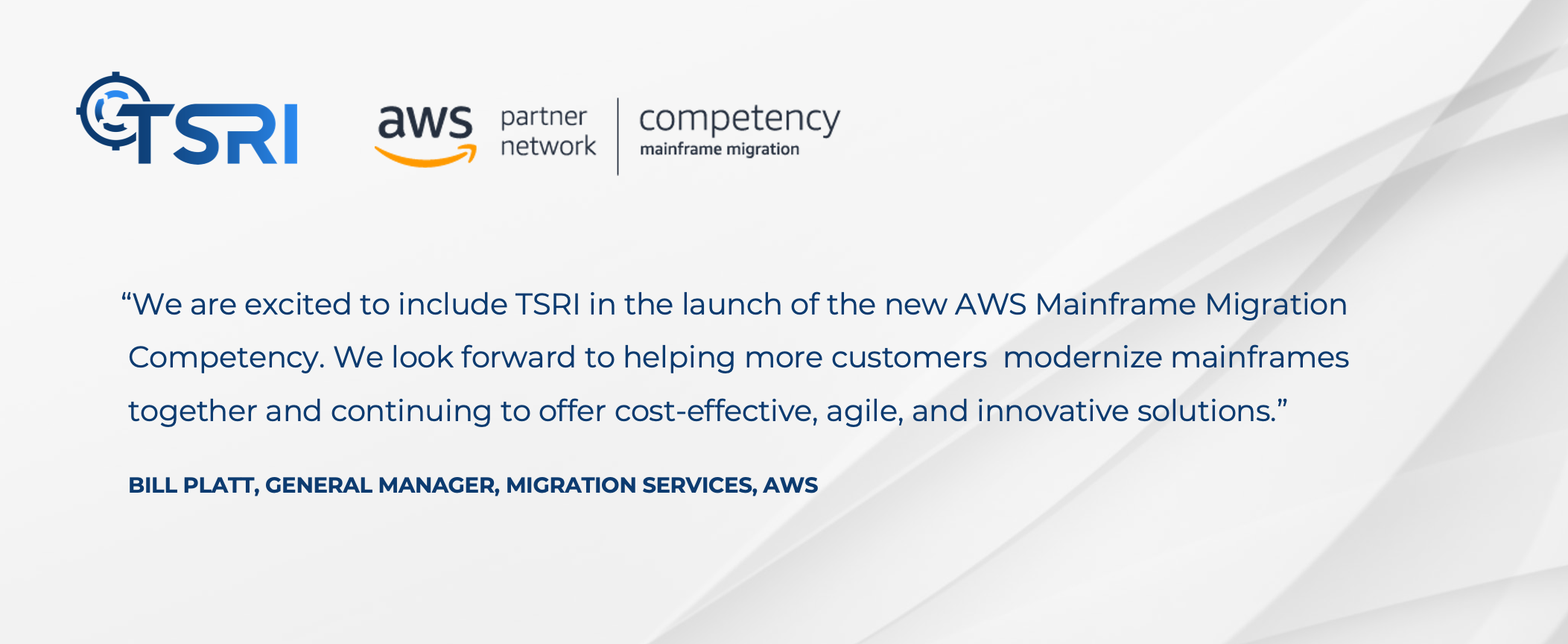
KIRKLAND, Wash., April 05, 2021 (GLOBE NEWSWIRE) -- The Software Revolution Inc. (TSRI) announced today that it has achieved Amazon Web Services (AWS) Mainframe Migration Competency status. This designation recognizes that TSRI has proven solutions, practices, and customer success in migrating both mainframe applications and data to AWS.
Recognizing the complexity of a mainframe migration, AWS customers seek proven methodologies, tools, and best practices to empower successful migrations. The AWS Partner Network (APN) plays a critical role in these efforts by providing access to mature technology products and services for customers’ mainframe migrations from AWS Partners with proven solutions and expertise.
AWS launched the AWS Mainframe Migration Competency to help customers confidently identify and engage AWS Partners who specialize in mainframe migration. These AWS Partners are vetted, validated, and verified against a high bar to achieve the AWS Mainframe Migration Competency. The high bar validates and verifies that AWS Partners with AWS Mainframe Migration Competency status offer mature solutions and practices and repeatable mainframe migration success.
Achieving the AWS Mainframe Migration Competency status differentiates TSRI as an AWS Partner with a track record of success and deep domain expertise in mainframe workloads migration.
“With this announcement, AWS puts a stake in the ground that modernization is vital to the health and security of governments and companies worldwide. The AWS Competency program encourages higher standards and better access for organizations looking to usefully leverage cloud technologies for their clients,” said Nicolas Newcomb, President of TSRI. “TSRI is honored to achieve AWS Mainframe Migration Competency status. We look forward to supporting successful modernization journeys for more organizations than ever before.”
TSRI enables technology readiness for the cloud and other modern architecture environments quickly, accurately, and efficiently with low risk and minimal business disruption. Their model-driven methods use 99.9X% automation to modernize and migrate mainframe applications, databases, and user interfaces into multi-tier, cloud-enabled architectures. TSRI’s iterative refactoring process repairs dead code and eliminates dead ends while their automated documentation engine enables today’s developers to more completely understand their system architectures.
“TSRI differentiates itself through experience and the speed and accuracy with which they transform legacy code,” said Sumeet Shrivastava, CEO of TSRI’s integration partner Array Information Technology. “Having a reliable partner like TSRI allows the Array team to do what we do best – develop upon the foundation of the transformed code toward wider reaching client objectives.”
Systems integrator NTT DATA partnered with TSRI to modernize a 50-year-old logistics system for the U.S. Air Force. “The United States Air Force required system modernization with no loss in functionality, no loss of performance, and adherence to price and schedule,” said Paul Saladna, Associate Director and Enterprise Architect at NTT DATA. “Throughout the project, TSRI proved to be an optimal partner who delivered on-time, on-budget, and to spec. They made the modernization process easy from start to finish.”
View the case study to learn more about how the U.S. Air Force modernized their technology with TSRI for AWS deployment.
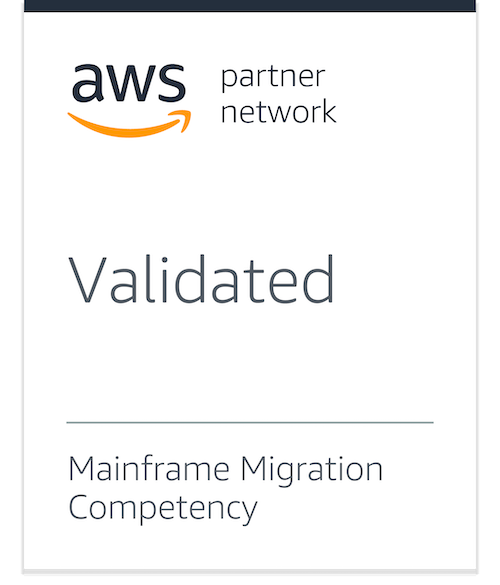 “Now more than ever, businesses are looking to migrate and modernize their mainframes with AWS. To help customers make the right choices when finding the most qualified AWS Partner for the job, we’ve created the new AWS Mainframe Migration Competency for customers to easily identify expert AWS Partners with repeatable mainframe migration success,” said Bill Platt, General Manager, Migration Services, AWS. “These AWS Partners are vetted by AWS for their mature solutions with proven customer migration success, and we are excited to include TSRI in the launch of the new AWS Mainframe Migration Competency. We look forward to helping more customers modernize mainframes together and continuing to offer cost-effective, agile, and innovative solutions.”
“Now more than ever, businesses are looking to migrate and modernize their mainframes with AWS. To help customers make the right choices when finding the most qualified AWS Partner for the job, we’ve created the new AWS Mainframe Migration Competency for customers to easily identify expert AWS Partners with repeatable mainframe migration success,” said Bill Platt, General Manager, Migration Services, AWS. “These AWS Partners are vetted by AWS for their mature solutions with proven customer migration success, and we are excited to include TSRI in the launch of the new AWS Mainframe Migration Competency. We look forward to helping more customers modernize mainframes together and continuing to offer cost-effective, agile, and innovative solutions.”
Learn more about TSRI’s approach to modernizing mainframe technology for AWS.
AWS is enabling scalable flexible and cost-effective solutions from startups to global enterprises. To support the seamless integration and deployment of these solutions, AWS established the AWS Competency Program to help customers identify AWS Partners with deep industry experience and expertise.
For more information about TSRI’s technologies and the benefits of cloud migration, or to begin your organization’s modernization journey, visit www.tsri.com.
About TSRI
TSRI – Software Modernization Assured
As a leading provider of fully automated software modernization services, TSRI enables technology readiness for the cloud and other modern architecture environments. We bring software applications into the future quickly, accurately, and efficiently with low risk and minimal business disruption, accomplishing in months what would otherwise take years.
View TSRI’s software transformation case studies, or contact us to start your modernization journey today.
Contact:
Greg Tadlock
This email address is being protected from spambots. You need JavaScript enabled to view it.
+1 (425) 284-2782
Microservices Offer Robustness and Security in Modern Systems
Microservices: The Architecture that Runs the Cloud
In past decades, software applications for organizations and enterprises were built as single systems designed to fulfill multiple business needs. These applications are often referred to as monolithic due to their enormous size and cumbersome nature. In a monolithic structure, all functionalities rely upon one another, making them very difficult to update or maintain—making changes in one area can create unknown failures in others. Additionally, maintenance and upgrades can be a very heavy burden not just for the system administrators, but for the business as a whole. Entire areas within the organization are often offline for hours or even days as administrators hold their breath to make sure the new/upgraded applications don’t break something else.
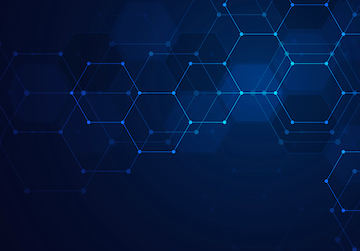 One of the most important architectural advances since the rise of cloud computing is microservices. Though not necessarily tiny in size, microservices offer an alternative by breaking down monolithic applications into multiple, single-purpose services that interoperate with—rather than depend on—each other. These decoupled services are highly flexible, scalable, reliable, and can run simultaneously across multiple applications.
One of the most important architectural advances since the rise of cloud computing is microservices. Though not necessarily tiny in size, microservices offer an alternative by breaking down monolithic applications into multiple, single-purpose services that interoperate with—rather than depend on—each other. These decoupled services are highly flexible, scalable, reliable, and can run simultaneously across multiple applications.
Microservices also make processes more efficient. They have the ability to communicate with one another to make a complete system and enable teams to use agile software development practices to deliver constant, ongoing software releases rather than forcing administrators to rely on single time-intensive upgrades.
From a business perspective, microservices can fulfill customer and employee requirements on an as-needed basis to provide new services and functionality. Their efficiency often means faster time to market on new products and services, and since they can be developed independently, organizations experience reduced risk with minimal business disruption.
Preparing to Move to a Microservices Environment
When considering modernizing monolithic applications and making the move to a cloud-based microservice architecture, you must first assess, tune, and optimize your applications for a successful effort. Consider these items when preparing for a modernization of your legacy mainframe systems to bring them up to par with today’s architectures and languages:
- Know your systems.
- In order to successfully modernize, understanding your existing systems is key. Obtain documentation and a detailed blueprint of your current architecture.
- Assess the appropriate target language.
- Microservices can be written in many different modern computing languages. Your business and operational needs can help drive this decision.
- Understand your data model.
How will your data interact with the microservices you build or employ, and how do you ensure that you do the appropriate due diligence to protect your own data as well as your customers’?
- Decide on cloud vs. on-premises (private cloud) deployment.
While cloud infrastructure becomes more secure by the day, if your systems are highly classified or include sensitive personal information, you may want to modernize to a private cloud that still allows you to employ microservices.
- Additional considerations – automation and refactoring.
While there are many different approaches to software modernization, the most accurate, efficient, and cost-effective option is a fully automated solution. Automation provides significant advantages over manual enhancements, not the least of which is a huge reduction in risk due to the introduction of human error to the modernized application.
A fully automated modernization includes a key component known as architectural refactoring. With refactoring, the application is re-engineered to improve the modernized system’s architecture, user interface, and maintainability. This iterative process also includes the removal of dead and redundant code while improving the quality and effectiveness through each pass. The refactoring process retains the functional equivalency of the original application while making the system more flexible, microservice compatible, and ready for cloud deployment.
Getting Across the Finish Line to Microservices and the Cloud
Modernizing your monolithic applications to microservices and the cloud is no easy feat. It will take a team of experts to not only focus on the tactical modernization of the software, but also work closely with you to put your organization on the path to success. This means working to understand your existing architecture with an assessment and documentation, developing a roadmap to your target language and architecture, and finally, getting you across the finish line with a fully modernized and improved application that’s ready for microservices and the cloud. This start-to-finish partner will be an invaluable ally in your efforts.
------
TSRI is Here for You
As a leading provider of software modernization services, TSRI enables technology readiness for the cloud and other modern architecture environments. We bring software applications into the future quickly, accurately, and efficiently with low risk and minimal business disruption, accomplishing in months what would otherwise take years.
Press Release: TSRI Celebrates 25 Years and Expands Modernization Offerings
KIRKLAND, WA – March 16, 2021 (GLOBE NEWSWIRE) — The Software Revolution, Inc. (TSRI), a recognized leader in fully automated software modernization, marks its 25th anniversary with new partnerships and solutions to meet an urgent need for the modernization of enterprise-scale applications. As organizations face diminishing resources, technical vulnerabilities, and rising costs, TSRI enables the rapid, low-risk modernization of systems that are critical to our society’s infrastructure. TSRI has demonstrated success in the military, government, and commercial sectors while delivering a full, end-to-end solution ready for cloud architectures and continuous DevSecOps maintenance and development.
Since the 1990s, TSRI has helped organizations migrate their systems into fully modern environments, databases, and languages. Its core technology, JANUS Studio®, is a model- and architecture-driven technology suite for automatic software modernization. Now in its third generation, JANUS Studio® is an advanced framework for automated assessment, documentation, transformation, and refactoring, tied in with DevSecOps processes. TSRI modernizes where engineering teams need help the most: languages such as COBOL, PL/1, JCL, Java, C#, MUMPS, Fortran, and Ada, as well as over 35 other supported languages, databases, and user interfaces. The sophistication and versatility of the model-based approach allows TSRI to modernize applications at an enterprise scale.

“Just as the Industrial Revolution took decades to transform 19th-century society and industry, TSRI is systematically applying formal methods and artificial intelligence to continuously transform and evolve software,” Philip Newcomb, Founder, Executive Chairman, and CTO of TSRI said. “JANUS Studio® is an industrial-scale technology for highly efficient and accurate analysis and transformation of code on a vast scale. Today, with the infrastructure of our society based on software, the need to expeditiously and reliably modernize these systems is more urgent than ever. Our approach is focused on providing semantic code transformation, which has enabled us to perform rapid, low-risk automated modernization for organizations who would have otherwise been left behind.”
Client Success Story
When NTT DATA was asked to modernize the United States Air Force’s (USAF) 50-year-old legacy mainframe Integrated Logistics Systems-Supply (ILS-S) Standard Base Supply Systems (SBSS), they queried leading software modernization vendors to assist, including TSRI. USAF wanted to reduce operating costs, improve system agility, and enable full mission readiness of its bases around the world. TSRI was chosen to help NTT DATA meet the USAF’s tight-turn and proof-of-concept trial.
“For this program, the United States Air Force required system modernization with no loss in functionality, no loss of performance, and adherence to price and schedule,” Paul Saladna, Associate Director and Enterprise Architect at NTT DATA said. “Throughout the project, TSRI proved to be an optimal partner who delivered on-time, on-budget, and to spec. They made the modernization process easy from start to finish.”

The result of NTT DATA’s successful effort, with TSRI’s assistance, is a fully modernized Java system deployed in the AWS GovCloud on over 260 U.S. Air Force bases around the world, saving the client CAPEX and OPEX costs, while allowing them to remain agile to business and program needs.
Looking Ahead
TSRI was recently named as a launch partner for Amazon Web Services’ Mainframe Migration Competency. In late 2020, the company launched DocsRev™, a code-level-based “Documentation-as-a-Service” product that enables organizations to easily take advantage of JANUS Studio’s® documentation while reducing operational and maintenance costs. In addition, TSRI is expanding its product and services, driving toward a fully integrated, continuous cloud modernization offering with DevSecOps functionality. This framework establishes a “modernization permanence” model, with on-going support required for continuous code and security deployment.
About TSRI
TSRI – Software Modernization Assured
As a leading provider of fully automated software modernization services, TSRI enables technology readiness for the cloud and other modern architecture environments. We bring software applications into the future quickly, accurately, and efficiently with low risk and minimal business disruption, accomplishing in months what would otherwise take years.
Media Inquiries:
Rebecca MacLeod
This email address is being protected from spambots. You need JavaScript enabled to view it.
+1 (206) 852-7403
Business Inquiries:
Greg Tadlock
This email address is being protected from spambots. You need JavaScript enabled to view it.
+1 (425) 284-2782
